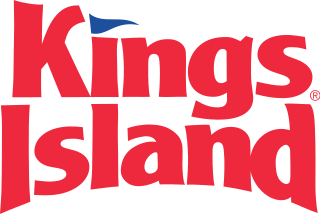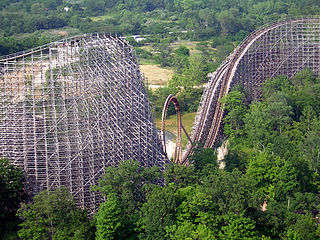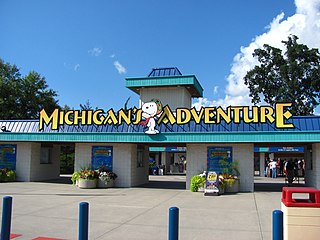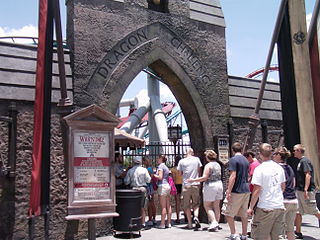Related Research Articles

A roller coaster is a type of amusement ride employing a form of elevated railroad track that carries passengers on a train through tight turns, steep slopes, and other elements usually designed to produce a thrilling experience. Trains consist of open cars connected in a single line, and the rides are often found in theme parks around the world. Roller coasters first appeared in the 17th century, and LaMarcus Adna Thompson obtained one of the first known patents for a roller coaster design in 1885, based on the Switchback Railway which opened a year earlier at Coney Island.

Kings Island is a 364-acre (147 ha) amusement park located 24 miles (39 km) northeast of Cincinnati in Mason, Ohio, United States. Owned and operated by Six Flags Entertainment Corporation, the park was built by Taft Broadcasting and opened in 1972. It was part of a larger effort to move and expand Coney Island, a popular resort destination along the banks of the Ohio River that was prone to frequent flooding. After more than $300 million in capital investments over the years, the park has grown to feature over a hundred attractions including fifteen roller coasters and a 33-acre (13 ha) water park.

The generic roller coaster vertical loop, also known as a Loop-the-loop, or a Loop-de-loop, where a section of track causes the riders to complete a 360 degree turn, is the most basic of roller coaster inversions. At the top of the loop, riders are completely inverted.

Top Thrill 2 is a launched roller coaster located at Cedar Point in Sandusky, Ohio, United States. The ride originally opened as Top Thrill Dragster in 2003, becoming the tallest and fastest roller coaster in the world, as well as the first ever strata coaster – a height classification of 400 feet (120 m) or more. Designed by Werner Stengel, the Accelerator Coaster model from Intamin debuted with a height of 420 feet (130 m) and could accelerate from 0 to 120 mph (190 km/h) in 3.8 seconds. It was themed to Top Fuel drag racing, with the launch track designed to resemble a dragstrip, and it consistently ranked as one of the world's top steel coasters in Amusement Today's annual Golden Ticket Awards publication. Top Thrill Dragster's records were surpassed in 2005 by Kingda Ka at Six Flags Great Adventure.

Kingda Ka is a hydraulically-launched steel roller coaster located at Six Flags Great Adventure in Jackson, New Jersey, United States. Manufactured by Intamin and designed by Werner Stengel, Kingda Ka opened as the tallest and fastest roller coaster in the world on May 21, 2005, surpassing Top Thrill Dragster. It is the second strata coaster ever built, exceeding 400 feet (120 m) in height. Both were made with similar designs, although Kingda Ka's layout adds an airtime hill on the return portion of the track.

Intamin Amusement Rides is a design and manufacturing company in Schaan, Liechtenstein, best-known for designing and constructing thrill rides and roller coasters at dozens of international theme parks, amusement parks and other establishments. The Intamin brand name is a syllabic abbreviation for "international amusement installations". The company has corporate offices across the world, including three in Europe, three in Asia, and two in the United States.

Son of Beast was a wooden roller coaster located at Kings Island in Mason, Ohio, United States. Built and designed by the now-defunct Roller Coaster Corporation of America (RCCA), the ride opened as the tallest and fastest wooden coaster in the world on April 28, 2000. Its record-setting height of 218 feet (66 m) made it the first wooden hypercoaster – a height class of 200 feet (61 m) or more. It was also the first wooden coaster in the modern era to feature a vertical loop and reached a record-breaking maximum speed of 78 mph (126 km/h). Son of Beast was marketed and themed as a sequel to The Beast roller coaster, one of the park's signature attractions that was built in 1979.

Batman: The Ride is an inverted roller coaster based on the DC Comics character Batman and found at seven Six Flags theme parks in the United States and at least one outside the US. Built by consulting engineers Bolliger & Mabillard, it rises to a height of between 100 and 105 feet and reaches top speeds of 50 mph (80 km/h). The original roller coaster at Six Flags Great America was partially devised by the park's general manager Jim Wintrode. Batman: The Ride was the world's first inverted roller coaster when it opened in 1992, and has since been awarded Coaster Landmark status by the American Coaster Enthusiasts. Clones of the ride exist at amusement parks around the world.

The Cyclone, also called the Coney Island Cyclone, is a wooden roller coaster at Luna Park in the Coney Island neighborhood of Brooklyn in New York City. Designed by Vernon Keenan, it opened to the public on June 26, 1927. The roller coaster is on a plot of land at the intersection of Surf Avenue and West 10th Street. The Cyclone reaches a maximum speed of 60 miles per hour (97 km/h) and has a total track length of 2,640 feet (800 m), with a maximum height of 85 feet (26 m).

Michigan's Adventure is a 250-acre (1.0 km2) amusement park in Muskegon County, Michigan, about halfway between Muskegon and Whitehall. It is the largest amusement park in the state and has been owned and operated by Six Flags since 2024. The park was previously owned by Cedar Fair from 2001-2024. As of 2024, Michigan's Adventure has over 60 rides, slides and attractions, more than any other park in the state.

Apollo's Chariot is a steel roller coaster at the Busch Gardens Williamsburg amusement park in James City County, Virginia, United States. The ride was the first Hyper Coaster designed by Swiss firm Bolliger & Mabillard. It officially opened to the public on March 27, 1999. This coaster is themed to the Greek and Roman god Apollo, who is the god of the sun, music, and healing. Apollo used his chariot to control the directions of the sun.

Raptor is a steel inverted roller coaster designed by Bolliger & Mabillard at Cedar Point in Sandusky, Ohio, United States. The coaster, which broke many records upon its opening in 1994, differs from previous inverted coasters. Instead of having a short layout designed to fit into a compact area like Batman: The Ride, Raptor was designed with a larger, 3,790-foot (1,160 m) layout, making it the tallest, fastest and longest inverted roller coaster in the world when it opened. It features six inversions, including a cobra roll, a first for inverted roller coasters. The ride is themed as a bird of prey.
Harry Guy Traver was an American engineer and early roller coaster designer. As the founder of the Traver Circle Swing Company and Traver Engineering Company, he was responsible for the production of gentle amusement rides like the Circle Swing, Tumble Bug, and Auto Ride. His roller coasters became legendary for their unique twisted layouts and thrilling, swooped turns. At a time when most coasters were built from wood, Traver was the first coaster builder to utilize steel for the primary structural material. He also built the first motorized fire engine in New York City.
The following article is a summary of notable incidents at the amusement parks and water parks that are operated by Six Flags Entertainment Corporation. In some cases, these incidents occurred while the park was under different management or ownership, such as legacy Cedar Fair parks.
This is a summary of notable incidents that have taken place at various Universal-owned theme parks, amusement parks, or water parks. This list is not intended to be a comprehensive list of every such event, but only those that have a significant impact on the parks or park operations, or are otherwise significantly newsworthy.
This is a summary of notable incidents that have taken place at various European amusement parks, water parks, or theme parks. This list is not intended to be a comprehensive list of every such event, but only those that have a significant impact on the parks or park owners, or are otherwise significantly newsworthy.

Flight of Fear is the name of two identical enclosed roller coasters located at Kings Island and Kings Dominion amusement parks. Built and designed by Premier Rides, they were the world's first launched roller coasters to feature linear induction motor (LIM) technology. Both locations opened as The Outer Limits: Flight of Fear on June 18, 1996, originally themed after The Outer Limits TV series that began airing in 1995 as a revival of the original 1960s series. Paramount's licensing rights to the TV show eventually expired without renewal, and all references to The Outer Limits were removed from the ride and its name in 2001.

Dragon Challenge, formerly named Dueling Dragons (1999–2010), was a pair of intertwined inverted roller coasters in the Wizarding World of Harry Potter area of Islands of Adventure in Orlando, Florida, United States. Designed by Bolliger & Mabillard of Switzerland, the ride was a dueling roller coaster featuring two tracks – one side was called Chinese Fireball and the other Hungarian Horntail – that were themed as two chasing dragons. Its layout involved two trains sharing adjacent lift hills, with each traversing unique courses. Trains on the Chinese Fireball track reached a maximum speed of 60 mph (97 km/h), while trains on the Hungarian Horntail reached 55 mph (89 km/h). Both tracks featured five inversions and an identical ride duration of 2 minutes and 25 seconds.
References
- 1 2 "Hot Jobs: Coaster man". Science World. 7 September 1998.
- 1 2 3 4 Zimmerman, Ann (29 October 2011). "Mastermind of the Mega-Coaster". Wall Street Journal. Retrieved 2 July 2013.
- ↑ Gray, Kevin (June 2012). "Engineer of Fear". Men's Journal. Retrieved 2 July 2013.
- ↑ Tugman, Lindsey (15 May 2013). "One man's mission to make roller coasters bigger, better". THV-TV. San Antonio, TX. Archived from the original on 2 July 2013. Retrieved 2 July 2013.
- ↑ Colimore, Edward (1 September 2002). "N.J. imposes a ceiling on park rides' G-forces". Philadelphia Inquirer. Archived from the original on March 4, 2016. Retrieved 2 July 2013.
- ↑ Pfister, Bryan J.; Chickola, Larry; Smith, Douglas H. (2009). "Head motions while riding roller coasters: Implications for brain injury". American Journal of Forensic Medicine and Pathology. 30 (4). Lippincott Williams & Wilkins: 339–345. doi:10.1097/PAF.0b013e318187e0c9. PMC 2796436 . PMID 19901817.
- ↑ "Larry Chickola". IMDb . Retrieved 2 July 2013.
- ↑ Bojorquez, Manuel (15 May 2013). "Engineer of Fear, America's Top Roller Coaster Architect". CBS News. Retrieved 2 July 2013.